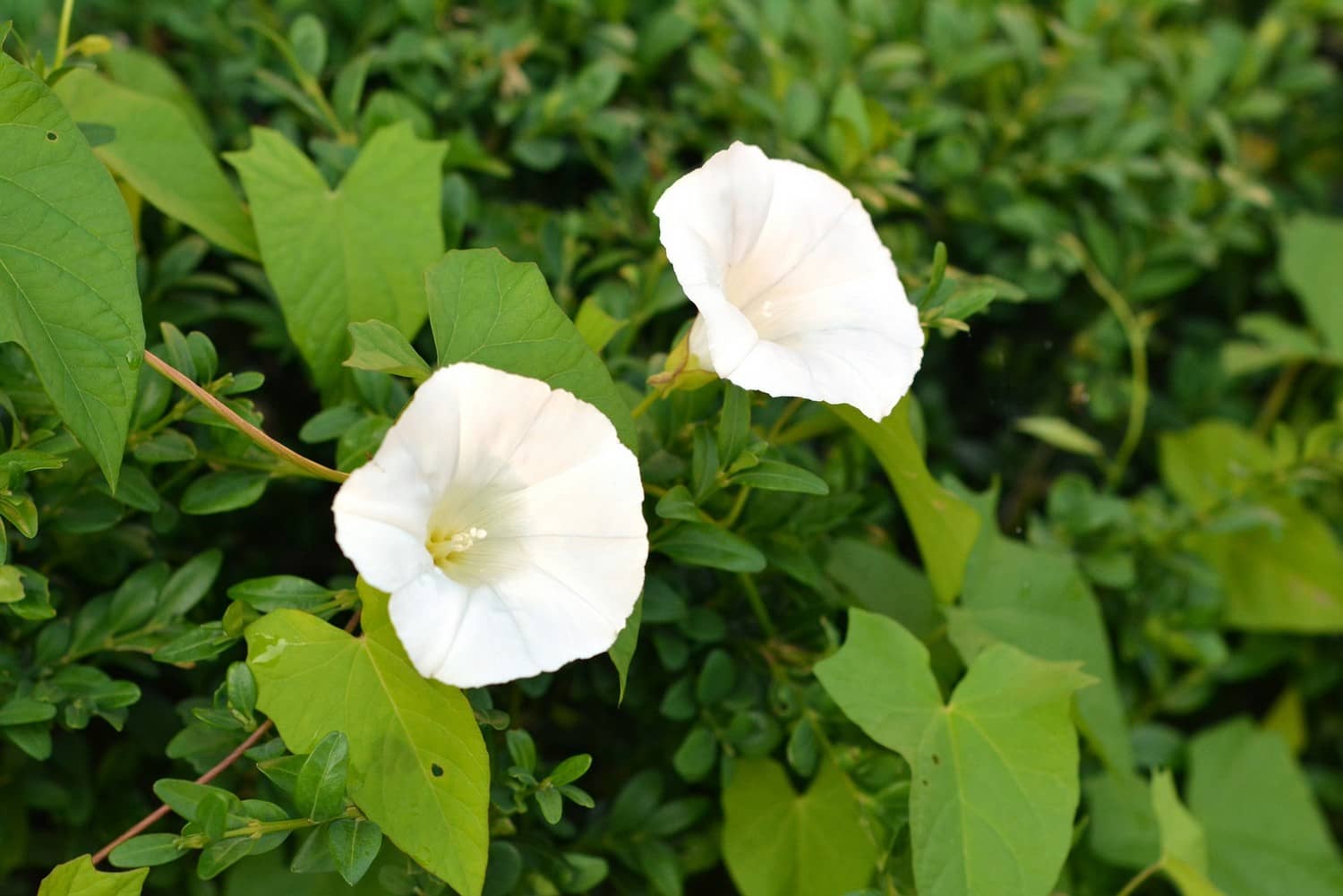
Bindweed: how to get rid of it?
naturally and without herbicide!
Contents
Bindweed is one of the most dreaded adventive plants among gardeners. Tenacious and prolific, this climbing plant twists around other plants, in hedges, on fences, … just about anywhere it finds a suitable environment and support.
The problem with bindweed is that it exerts strong competition: it captures water, light, and nutrients from the soil while smothering nearby plants.
In this advice sheet, you will find effective anti-bindweed solutions to combat naturally against hedge bindweed (Calystegia sepium) and field bindweed (Convolvulus arvensis), while avoiding the use of herbicides.
Manual techniques, solarisation, thermal weeding, planting toxic plants for bindweed roots (Tagetes patula, minuta), sowing green manures… Let’s see how to get rid of bindweed for good, or almost!
Hedge bindweed or field bindweed?
To combat effectively, one must know their enemy… Let’s first look at the two main types of bindweed.
1. Hedge Bindweed
Hedge bindweed produces a multitude of immaculate flowers at the end of summer, primarily in hedges, fallow land, wire fences, or enclosures. It is highly invasive as its roots are extremely difficult to eradicate, and its voluble stems grow quickly, colonising plants and fences by twisting in a clockwise direction.
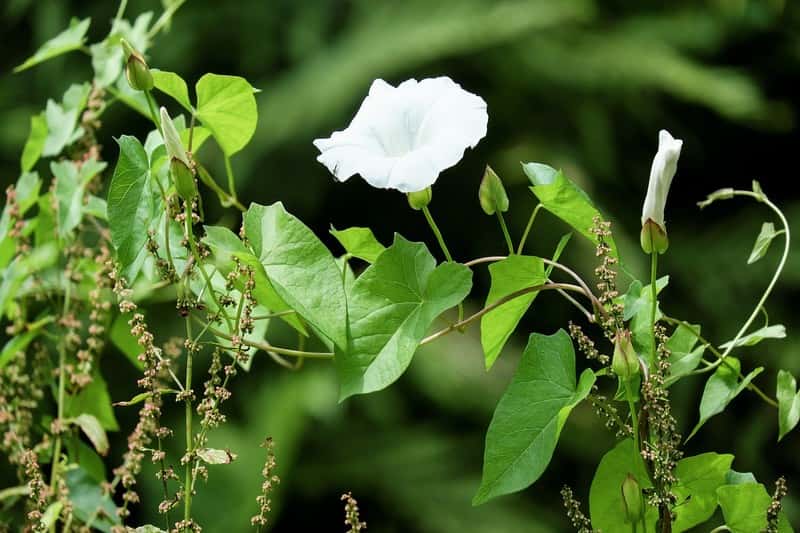 Hedge bindweed twines around neighbouring plants.
Hedge bindweed twines around neighbouring plants.
It is recognised by its large arrow-shaped leaves, a vibrant green, alternating on slender voluble stems. The flowers of hedge bindweed are trumpet-shaped, white, and measure 30 to 50 mm in diameter. They close in overcast or rainy weather but can remain open day and night. Flowering occurs from July to September.
Hedge bindweed first forms a taproot, then several types of stems:
- voluble stems that climb up to 3m and produce flowers,
- creeping stems, shorter, that form rootstocks,
- very long stems up to 10 metres, ramified and devoid of flowers. In autumn, the tips of these stems bend to root in the soil and become a rootstock that will produce new shoots the following spring.
The plant can reach 6 m in height, and its roots allow it to draw water from deep down, up to at least 50 cm.
2. Field Bindweed
Field bindweed often covers the soil of arable land, fallow land, paths, and gardens. It twines around crops or low plants.
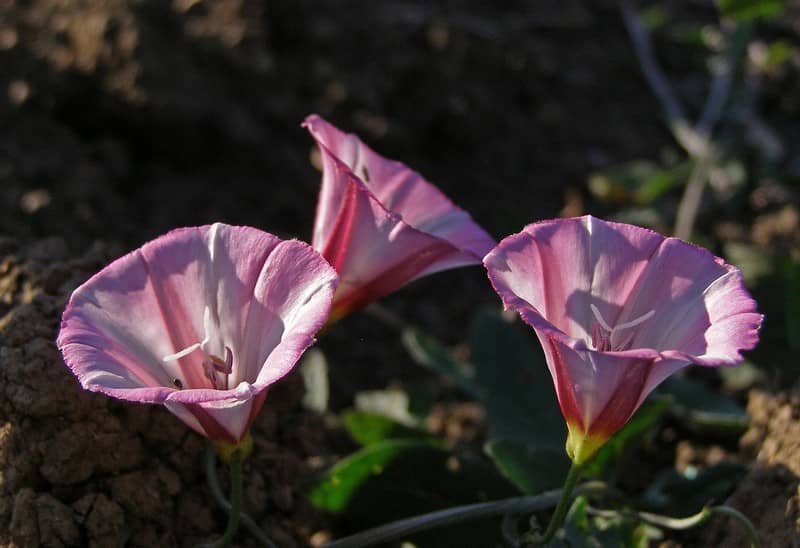 The pink trumpet flowers of field bindweed.
The pink trumpet flowers of field bindweed.
Smaller than those of hedge bindweed, its flowers are often very colourful like sweets. They measure between 20 and 30 mm in diameter. Sometimes white, they are most often pink striped with white. Photosensitive, they only fully open in bright sunlight. Otherwise, they remain closed like a folded umbrella. Flowering occurs from June to September. A single plant can cover the ground over a diameter of 3 m. Finally, it is worth noting that field bindweed is more manageable than hedge bindweed.
They prefer clayey and heavy soils, but the presence of bindweed mainly indicates a soil rich in nitrogen.
The dissemination of the very fertile seeds occurs through wind and birds. Coupled with rapid growth of both the aerial part and the roots, this results in a formidable coloniser.
 White roots of bindweed.
White roots of bindweed.
How to combat bindweed?
-
Manual Removal
This is an effective method, but it requires patience. Intervene at the end of winter, using a fork or a bio-fork to remove as many roots as possible. To be effective, this operation will need to be repeated for several years, especially if the area is heavily infested. During the season, all regrowth should be carefully removed, either by pulling or hoeing.
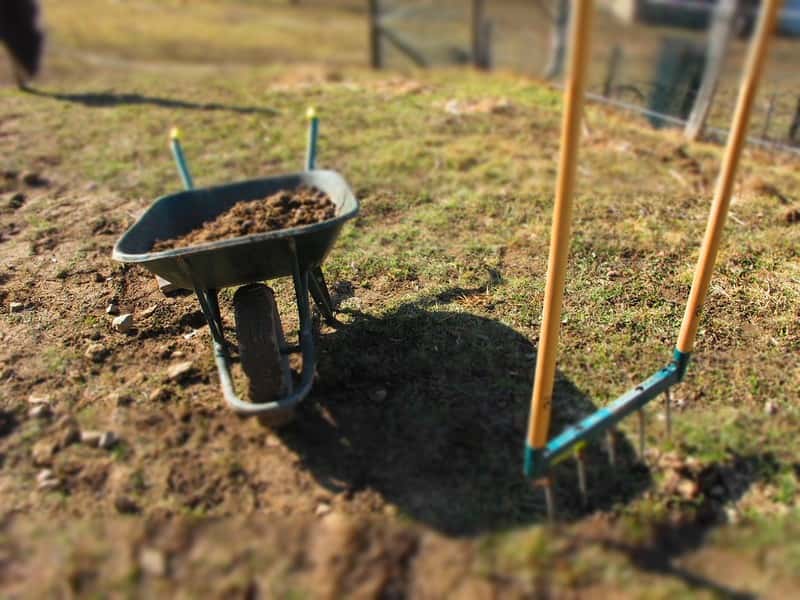
The bio-fork is very handy for loosening the soil on the surface without turning it over.
-
Solarisation
Solarisation is a proven method. To implement it, simply place an opaque cloth for 18 to 24 months. The bindweed will exhaust its reserves in search of light. The cloth must be permeable to water to prevent the bindweed from simply going dormant and waiting for its chance to return with force. It is also important to ensure the edges of the cloth are buried. After this time, the roots will need to be extracted carefully, taking care not to break them with a sharp tool.
-
Thermal Weeder
This technique weakens the bindweed, but does not eliminate it! The principle of the thermal weeder is to bring a source of intense heat close to the plant to be removed. This thermal shock destroys the cells of the plant. The use of a thermal weeder is more suitable for paths and paved terraces, but not for flower beds where it would cause significant damage to the plants entwined with the bindweed. Finally, be careful not to start a fire in at-risk areas!
-
Mulching
Mulching (chipped pruning or tough leaves like those of bamboo) applied in a thick layer slows down the growth of bindweed and even though it often manages to sneak through, it is a means of containing its growth.
-
The Tin Can Trick
It is possible to place a turned-over tin can on a bindweed shoot. The shoot will grow inside the can and exhaust itself in search of light, but this trick is not feasible in a bed overrun with bindweed… unless you want a garden full of tin cans!
-
Tagetes (Marigolds) and Green Manures
It is sometimes recommended to plant tagetes to combat bindweed. Although we have not yet tested this method, the experiences of some gardeners indicate that marigolds do not cause real harm to the roots of bindweed. Unfortunately, the same seems to apply to sowing green manures (rye, vetch) which do not slow down bindweed.
We advise against the use of herbicides, as they are ineffective and harmful to the environment. However, if you decide to use phytosanitary products like glyphosate, apply the product with a brush on each leaf, wearing gloves, long-sleeved clothing, and a mask. Also, remember to protect the soil with several layers of newspaper. You have been warned!
How to prevent invasion?
To avoid bringing bindweed into your garden, be wary of any external soil or compost that may contain roots or seeds.
If, despite your precautions, it has settled in your flower beds:
- pull up all aerial parts to prevent seed dispersal
- do not skimp on mulching: a thick layer (15 cm) helps slow down the growth of bindweed,
- when working the soil, remove as many roots as possible by lifting the soil with a fork or a broadfork. Burn the roots once dried.
- do not use a rotavator or a spade that will fragment the roots. Each piece can regenerate a plant. Bindweed thrives in overworked soils.
- Persevere, it pays off: bindweed must never be given the chance to rebuild its reserves.
- use a gouge to extract bindweed from the ground as deeply as possible.
- avoid planting in a “contaminated” area by bindweed thinking you will remove it gradually: it is much more difficult, and your young plants will struggle to compete against it.
A "weed" that has more than just flaws
This wild one has its merits, and you may find yourself having to coexist with it… and to make “the best of a bad situation“!
Be aware that:
- its melliferous flowers are highly appreciated by pollinators,
- bindweed is also an organic indicator plant, revealing soil that is too rich in nitrogen and possibly indicating an excess of fertilisation.
- The aerial parts of bindweed enrich compost with nitrogen and trace elements, while the roots aerate heavy soils.
There are, in fact, other species of bindweed, non-invasive, cultivated for their pretty coloured trumpets:
- Water bindweed (Ipomoea aquatica) is an edible bindweed whose young shoots and leaves are used in Asian dishes.
- The blue bindweed is also known as morning glory (Ipomea indica or learii), a vigorous annual or perennial liana in the South, with large flowers of an incredible blue.
- The Turkish bindweed (Convolvulus cneorum) is a shrub with white flowers and silver foliage, suitable for Mediterranean climates.
- Finally, the Mauritanian bindweed (Convolvulus sabatius) is a trailing annual plant, perfect for hanging baskets.
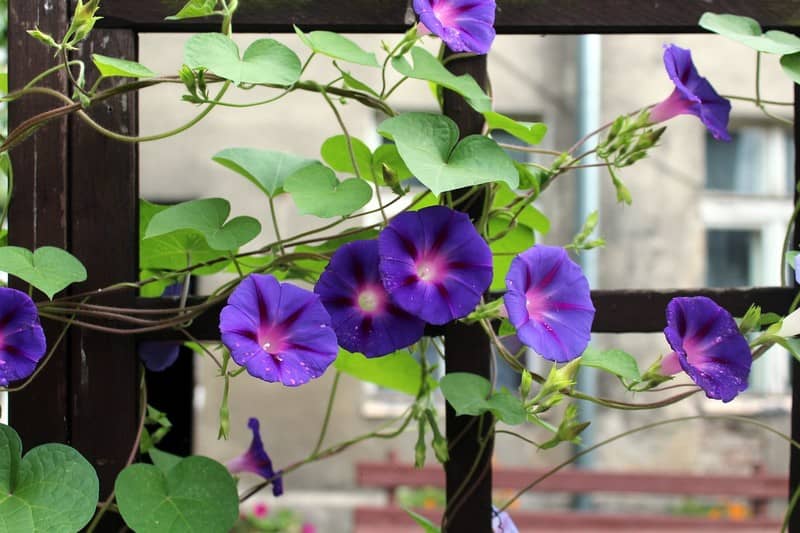
The beautiful blue-violet flowers of Ipomea indica.
- Subscribe!
- Contents































Comments